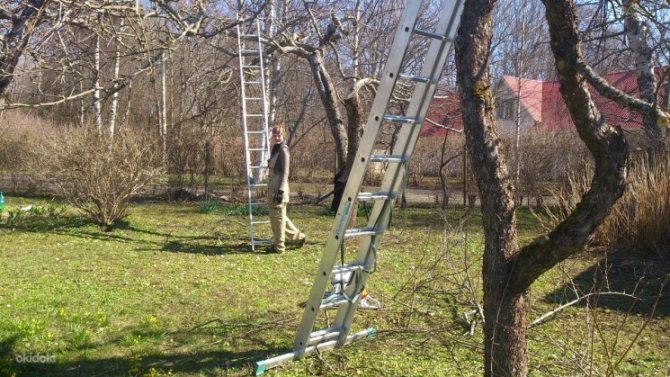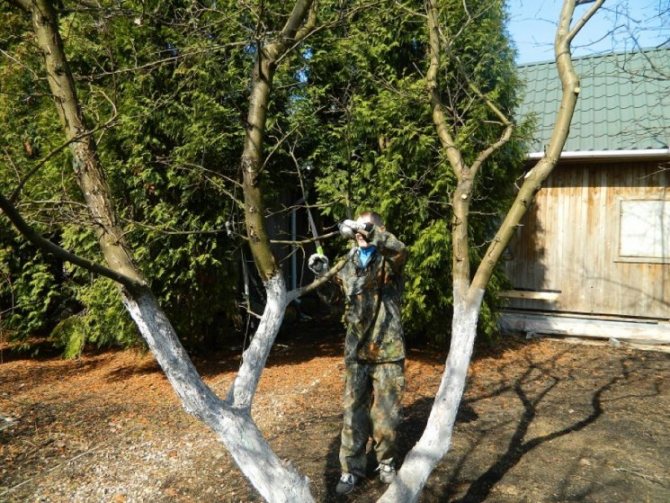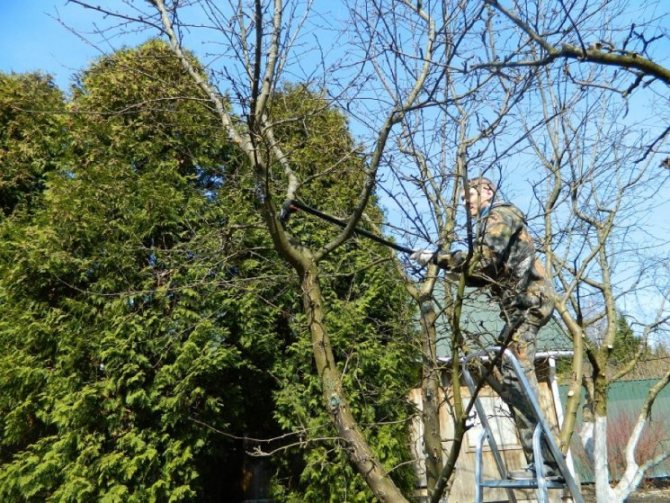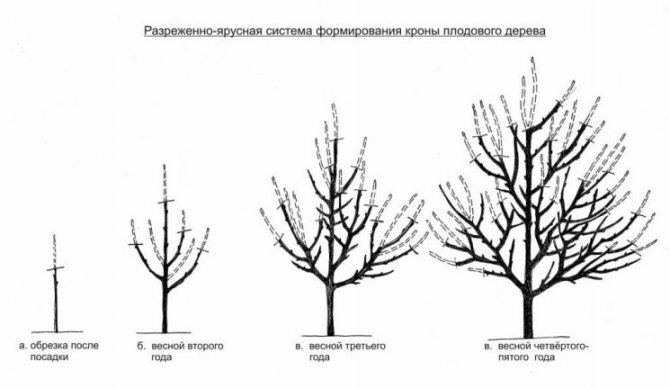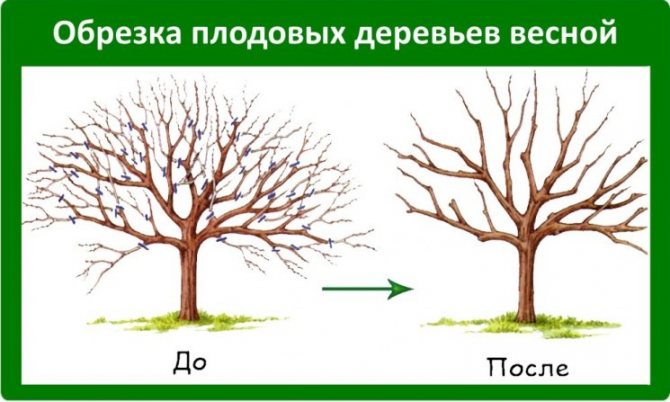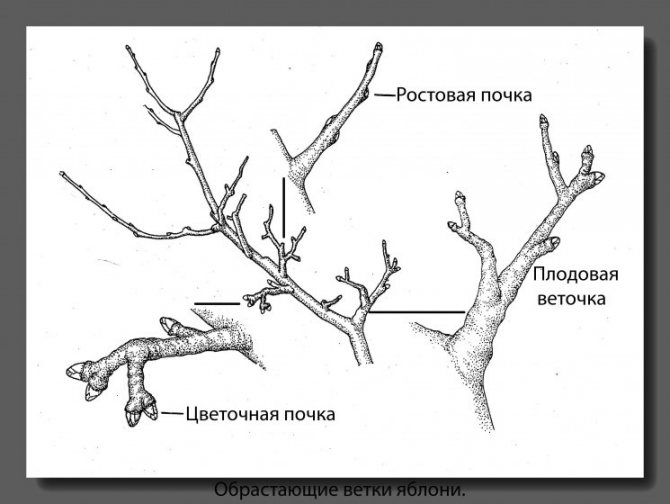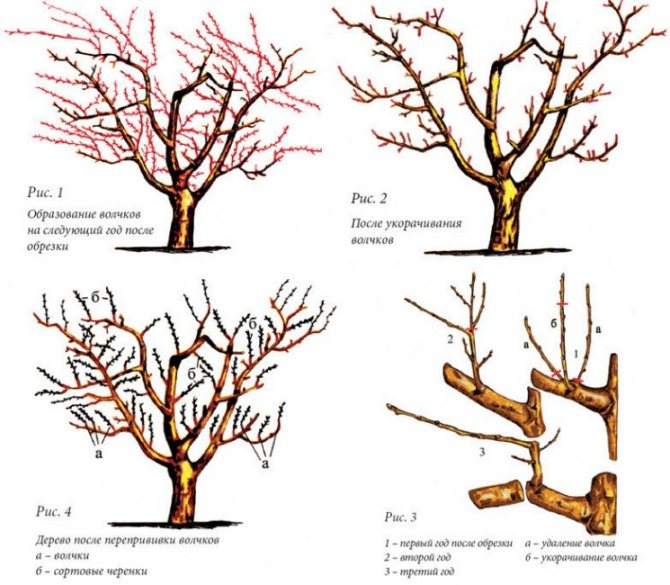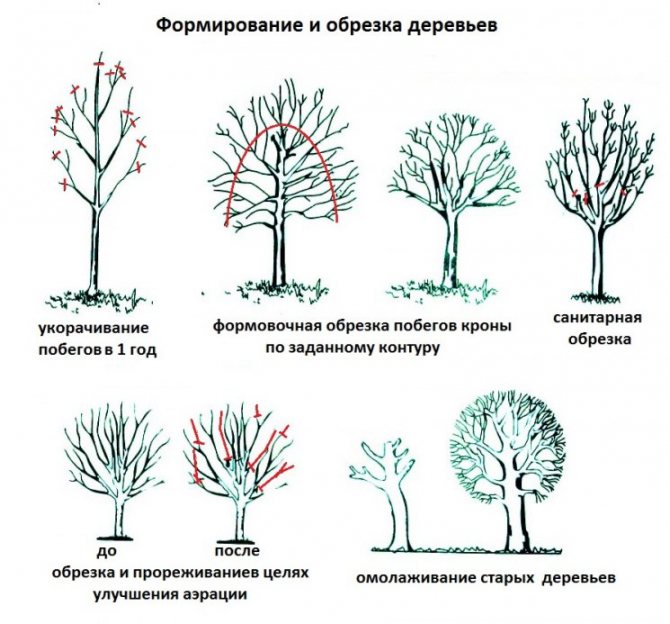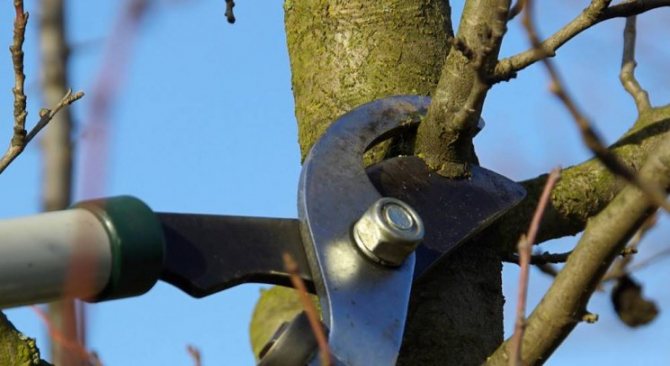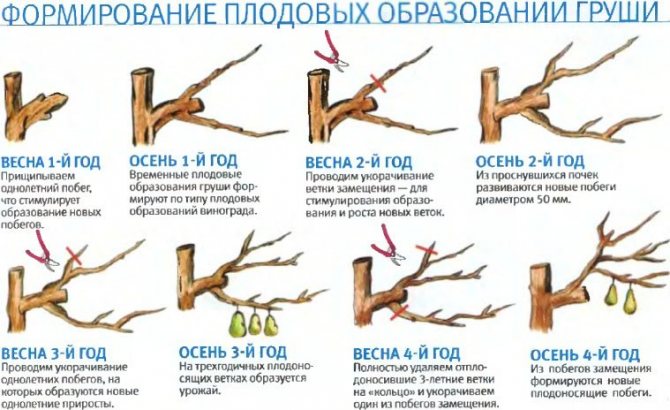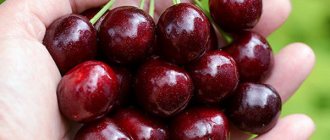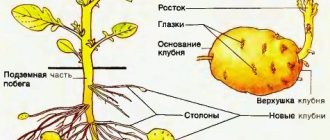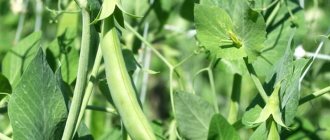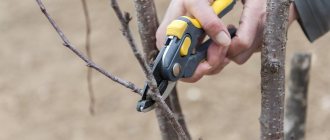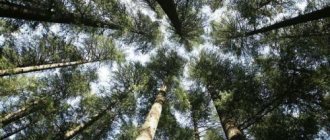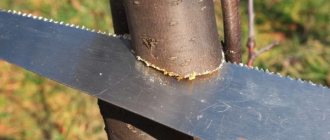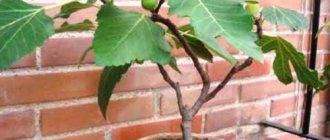Forming and pruning fruit trees is the key to creating various crown designs, limiting their size, adjusting the light regime.
In this way, the excessive height and volume of trees is eliminated, the leaf area is rapidly growing, good illumination of all sections of the crown and its sufficient strength are achieved.
Pruning
Pruning of fruit trees is carried out in order to form them, regulate growth and fruiting, improve the quality of fruits, improve crown lighting, rejuvenate, remove dry, diseased and broken branches.
It is possible to regulate growth and fruiting not only by pruning, but also by changing the position of the branches by bending, twisting, tying.
Pruning makes it possible to grow trees of the required size with a strong trunk that can withstand a large load (crop weight), ensures long-term preservation of productivity and overgrown wood, timely entry of trees into the season of fruiting and obtaining good-quality fruits, and also softens the frequency of fruiting.
Incorrect and inept pruning can lead to unwanted thickening of the crown, to later fruiting and a decrease in winter hardiness due to poor maturation of wood and protracted growth at the end of the growing season.
Taking into account the biological characteristics of the species and varieties of fruit trees, before starting pruning, it is necessary to determine its purpose and results.
Pruning methods
There are two pruning methods: shortening and thinning. Pruning (pruning) partial removal of the upper part of the shoots, branches and fruits. Removing 1/5 to 1/4 part of the annual growth is weak shortening, 1/3 to 1/2 part medium, 1/2 to 2/3 part strong.
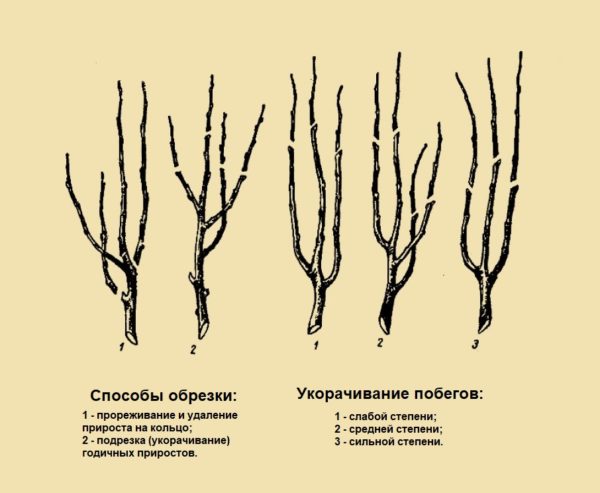
Pruning branches for 2-3 years old wood (removal of growth of the last 2-3 years) is called light rejuvenation (or chasing), for 4-6 years, moderate rejuvenation, removal of a significant part of overgrown wood of skeletal branches by strong rejuvenation. Shortening the fruit is called detailed pruning.
Shortening enhances shoot growth, stimulates the development of buds below the cut, and promotes thickening of the branches. Vigorous and systematic pruning reduces the volume of branches and trees in general and, as a result, leads to their weakening.
Thinning (cutting) removal of shoots, branches and fruits entirely on the ring. Thinning protects the crown from thickening, most fully contributes to the improvement of the air-light regime of the crown and, as a consequence, to the strengthening of fruit formations.
Both during shortening and thinning, there is a redistribution of nutrients and water. They are directed to those parts of the plant, the growth of which is desirable to enhance. As a result of pruning, the number of buds that consume nutrients is reduced, the path from roots to leaves is reduced, therefore, growth is enhanced.
The vigorous shoot growth caused by pruning promotes the formation of branches with good water carrying capacity.
Pruning technique
When shortening a one-year shoot, an oblique cut is made above the bud (on the bud) without leaving a spine. The cut should be on the opposite side of the kidney, its lower end is slightly higher than the base of the kidney, and the upper end is at the level of its apex.
When pruning branches above the lateral branch, leave a spine 1-2 cm long. The shortening of thin branches and shoots is done with a garden knife or pruning shears, and thick branches with a garden saw.
When thinning, the branches are cut into a ring. In this case, the plane of the cut should be parallel to the sag at the base of the branch. A stump should not be left near the influx, as this makes it difficult to overgrow the wound.
You cannot cut a shoot or branch below the annular bead, because the wound area increases. When cutting thin branches and annual shoots, the cutting part of the secateurs should be directed towards the branch, and not towards the cut off part, so as not to wrinkle the fabric near the cut.
When cutting with a saw, the branch is first cut from the bottom by 7th of its thickness in order to avoid tearing off the bark below the cut and then the cutting is finished from above.
Very thick branches should first be shortened and then cut into a ring. Cuts made with a saw are cleaned with a sharp garden knife, achieving a flat surface.
Wounds over 2 cm in diameter are covered with garden varnish, oil paint on natural drying oil or a mixture of nigrol and ash.
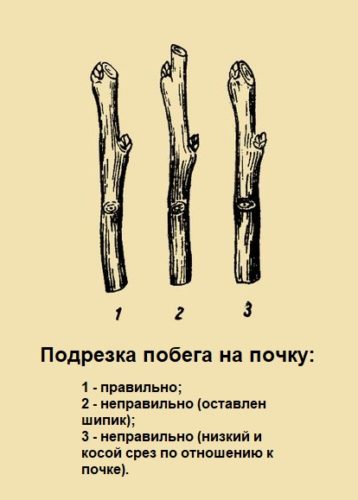

Pruning time
In the conditions of the North-West zone, fruit trees should be pruned in the winter-spring period and in the summer. The main pruning of the tree is carried out during the dormant period of the tree from the moment the severe frosts stop until the beginning of the growing season (end of February May), when there is no danger of frost damage to the pruned trees, and nutrient reserves are not lost with the removed part of the tree.
However, it was found that in the non-chernozem zone, including in the Leningrad region, the pruning period can be extended until mid-June (during the flowering period).


It is advisable to follow a certain order of pruning, depending on the breed and the state of the plantings. By pruning the apple tree, as it is more resistant to adverse natural conditions, you can start and finish this work.
Trees planted in the previous fall should be pruned prior to sap flow. Pruning of stone fruit is also done before bud break. It is not recommended to rush to prune trees severely damaged by frost.
Dryness can only be cut after the damaged parts of the branches are clearly visible. Summer pruning primarily includes pinching (pinching) removal of the tops of growing shoots. Pinching is done with nails, and when removing most of the shoot with pruning shears.
Pinching has a strong effect on the tree. It takes a lot of working time to carry it out. However, this method of pruning allows for a more economical use of the nutrients entering the plant.
This is explained by the fact that during pinching, the required shoot length is achieved by stopping its growth, while when shortening a one-year shoot in the next spring, a significant part of it is removed, for the formation of which nutrients have already been spent.
The reaction of a fruit tree to pinching depends on the period of its application. During the period of intensive growth (June), the pinching of vigorous shoots above the 5-6th leaf retards their growth. This promotes the formation of pinched shoots from the axillary buds of summer premature shoots, enhances the growth of weak shoots located next to the pinched ones, the transformation of leaf buds into fruit buds.
It should be noted that pinching often delays the growing season, and this can adversely affect the overwintering of trees.
Pinching, carried out during the period of damping of shoot growth, improves the development of axillary buds and promotes the maturation of the shoots.
Pruning is related to the age of the tree. In different periods, the nature of the growth and fruiting of the tree changes, the tasks and means of pruning change.
Young trees are characterized by intensive growth and an increase in crown volume.From the moment of entry into the season of fruiting, growth processes slow down and the rate of processes that ensure fruiting increases. In an aging tree, the processes of drying out, resumption of growth (formation of tops, overgrowths) and decay of fruiting prevail.
The formation of the crown during the life cycle of a fruit tree is subject to the regular alternation of two processes: self-thickening and self-thinning. Professor P.G.Shitt has established a cyclical pattern in the change of skeletal and overgrown parts of the tree crown.
In young trees, an increase in crown volume is accompanied by its thickening. Then, due to the changed conditions' illumination and nutrition in the crown, the oldest fruit formations begin to die off, and the crown is thinned out from the center to the periphery.
Further, such a state of trees occurs when the branches dry out from the ends and is accompanied by a secondary thickening of the crown due to the formed spinning shoots.
Also read: How to fulfill the dream of an English garden on your site
Usually, after the first large harvests, the crown changes its shape and becomes more drooping, spreading. The slowed down flow of nutrients to the ends of the bent branches leads to the formation of strong spinning top shoots in the places of their fold. Further, the process of dying off of the ends of the bent branches progresses.
Drying of the tops of the branches upsets the balance between the volumes of the root system and the crown, which leads to the formation of new, stronger tops inside the crown. Thus, the second thickening of the crowns occurs due to the spinning shoots.
Thickening and thinning of the branches formed from the topside shoots proceeds in the same sequence as other branches of the crown, but it takes more time.
The branches of an old tree can be completely replaced by branches formed from top shoots. When pruning, it is important to regulate the acceleration or deceleration of the natural processes of crown formation.
Pruning apple and pear before fruiting
The length of the period from planting to fruiting depends on the biological characteristics of the breed and variety. In early-growing varieties of apple and pear, ripening begins at the 4th-5th year, and in the late-full ones at the 10th-12th year. During this period, the aim of pruning is to shape the trees according to the chosen system.
The most common forms of apple crown in the North-West zone are whorled (five-branch) and combined. Bushy and tiered are less common.
What is tree pruning
Considering the offered in a wide variety of photos of pruning fruit trees, you can see the simplicity and availability of this method of caring for green spaces.


A simple and fairly easy procedure provides various effects, making it possible to expand the range of measures for caring for fruiting crops:
- growing trees of the required size with a certain strength of the trunk to bear large fruits;
- long-term preservation of the best fruiting conditions with normal lighting of the branches and easy harvesting;
- timely formation of ovaries and fruits due to the correct and even distribution of liquid;
- compliance with the regularity and timing of fruiting under changing climatic and weather conditions.
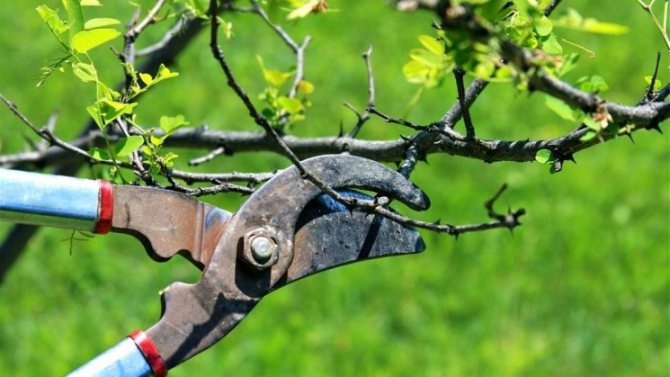

The purpose and required results of crown formation are determined individually, they are influenced by the biological characteristics of fruit plantations. Before choosing a technique and technology, the type and method of introducing an agrotechnical procedure, a novice gardener should definitely take into account the breed and variety of a cultivated plant.


Whorled-tiered (five-knot) crown.
When forming a whorled crown, 4-5 branches are left in the lower tier, formed from adjacent buds. The second tier has 2-3 branches located through one I bud.
The distance between the first and second tiers of branches should be about 50-70 cm. Practically limited to laying only the branches of the first tier. In large production gardens, no more than two tiers are laid and the guide is allowed to develop freely.
In most apple varieties, the conductor naturally deviates from the vertical with age and takes the position of a lateral branch.
The total number of large skeletal branches on the apple tree is 8-12. Crown formation according to the whorled (five-knot) system is not difficult, since the choice of branches is not particularly difficult.
However, the formation according to the five-day system has a number of disadvantages. The crowding of skeletal branches does not ensure their strong fusion with the trunk and inhibits the development of the central conductor. The bases of the branches and the trunk in the forks are more likely to suffer from frost than in the crowns with a sparse distribution of branches.
Combined crown. The above-mentioned drawbacks does not have a crown formed according to the combined system. Here, the first tier is formed by three bitches, placed, depending on the variety, through 2-3 buds at a distance of up to 15 cm from each other.
Sometimes it is allowed to choose two branches from adjacent buds, provided that they are directed in different directions (have a large angle of discharge).
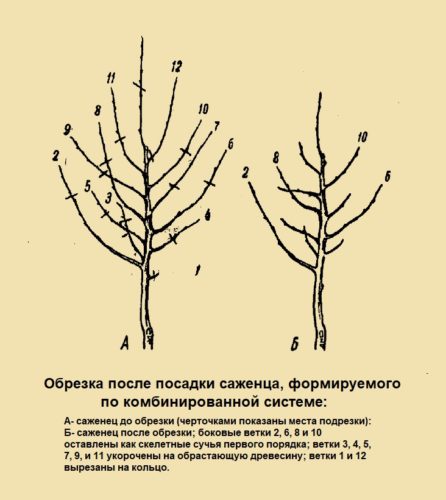

Often, another spare shoot is left in the tier, which is used in the event of a breakdown of one of the selected skeletal branches.
The next (fourth) skeletal branch is laid at a distance of 35-45 cm from the first tier, and all the others are laid singly after 30-40 cm. Depending on the growth strength of the variety, 6-8 skeletal branches are laid.
What tools will be useful for a novice gardener
Even a novice gardener will need a certain set of tools that will help to carry out the procedure correctly and competently. Depending on the state of the garden and the presence of trees or shrubs in it of a certain height and lifespan, the master may need the following specialized devices:
- manual pruner, when choosing such a device, it is better to avoid the presence of a ratchet mechanism, it is better to make a single cut with one press;
- a garden hacksaw, a saber-shaped and sharp tool that helps to get rid of fairly large branches without sawdust and shavings accumulating in the teeth;
- air pruner, not a complicated design, is a pruner on a telescopic shaft, which ensures cutting of high-lying branches.
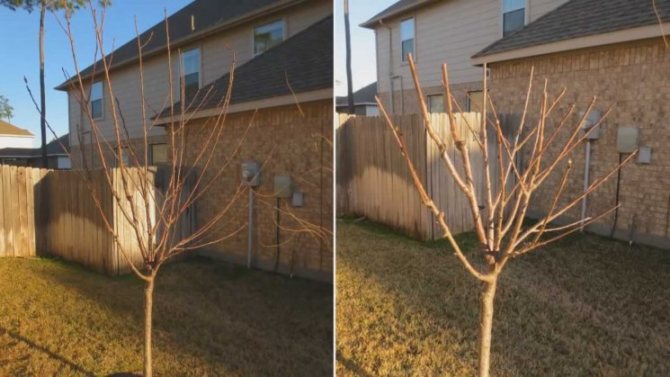

Bushy crown.
For the North-West zone, the bush-like shape of the apple tree crown is of great interest. Trees with such a crown are small (4 m). It is convenient to look after them (pruning, fruit picking, spraying, etc.).
A bushy crown begins to form in the nursery by pruning an annual seedling. After planting in the garden, 5-6 skeletal branches are selected on the tree, located at a distance of 10-15 cm from each other, and the shoots located between the selected branches are cut out.
Pruning after planting is carried out in the spring before bud break, in order to restore the correspondence between the volume of the crown and the volume of roots reduced when digging out seedlings. Annual branches are shortened by 1 / 3-1 / 2 of their length approximately at the same level from the soil surface, while the lower shoots remain longer, and the upper ones are short.
The guidewire is removed over the last lateral branch after it has taken a stable direction of growth. This crown formation system gives good results on vigorous and abundantly branching varieties.When forming trees of weakly growing and weakly branching varieties, it is very difficult in the first two years to collect three strong close branches at the indicated distances.
Tierless, modified leader crown.
For a non-tiered formation system, skeletal branches are placed at a distance of 15-40 cm from one another. The convergence of branches is allowed in some cases, especially in the first years, when the tree is still growing slowly.
The total number of skeletal branches is 5-6, and in vigorous and abundantly branching varieties up to eight. The advantage of this system is the good illumination of the crown and the strength of the connection of the skeletal parts.
However, one has to reckon with the fact that fruit trees in the first years after planting are characterized by slow growth. At large distances between skeletal branches, their number in the crown is slowly replenished. Low-branched, with insufficient leaf apparatus, apple trees develop poorly, their winter hardiness in the first years after planting in the garden is reduced.
The length of the remaining part of the lower shoots should be at least 35-45 cm. Weak branches may not be cut off. The guide is pruned at such a height that it is 15-20 cm higher than the tops of the skeletal branches in varieties with a spreading crown and 25-30 cm in varieties with a pyramidal crown. The escape of the rival conductor is cut into a ring.
The main requirement for the formation of a strong skeleton of a tree is compliance with the rule of subordination (in thickness and length) of skeletal branches of the first order to the conductor, branches of the second order to branches of the first order, etc.
The main conductor should have a stronger development than skeletal ramifications, and the thickness of the branches should not exceed 0.5-0.6 of the trunk diameter. This is one of the conditions for strong fusion of skeletal branches with the trunk. The branching angles from the trunk should be wide enough (at least 45 °), which also contributes to the formation of a strong tree skeleton.
The branches in the crown should be evenly spaced along the trunk and in space, so that all its parts are well lit. In order for the branches to grow in the right direction, when pruning, it is necessary to take into account how the buds are located on them.
In varieties that form sprawling crowns with hanging branches, the shoots are cut to the inner bud, which helps to maintain the vertical growth of the branches; in varieties with pyramidal crowns, the formation of a wider crown is achieved by pruning on the outer bud.
In some cases, a branch is cut on a lateral bud in order to change its position in the horizontal plane, for example, if necessary, separate two branches that are relatively close to each other. Sometimes, to change the direction of the shoots, they are tied up.
When pruning, it must be borne in mind that fruit plants have an apical growth pattern. The central shoot grows most strongly, and lateral ramifications are weaker. Lateral branches located at an acute angle grow stronger than branches of the same order, forming a more obtuse fork.
The bent position of the branch leads to attenuation of growth processes and promotes the laying of fruit formations. Knowledge of the peculiarities of tree growth makes it possible to achieve the necessary subordination of the branches. For example, with a garter, the lower branches, which have a position close to horizontal, are given a vertical position, as a result, their growth is enhanced.
Branches growing at an acute angle to the trunk are shortened more than neighboring branches branching off at a wider angle. This pruning reduces competition between branches for food. Within 3-4 years after planting, the next skeletal branches of the first and subsequent orders are laid.
The branches of the second order are placed in a horizontal plane at some distance from the trunk.
Also read: Bonsai is a favorite hobby


In trees formed according to the five-knot system, branches of the second order are laid at a distance of 30-40 cm from the trunk and from each other.
In trees formed according to the combined system, the first branches of the second order are also laid at a distance of 30-40 cm from each other, but on the three lower branches 30-40 cm from the trunk, and on the next ones at 40-60 cm. Such an arrangement of branches provides good lighting of the crown from above. The branches of the second order are subordinate in thickness and length of the main branch on which they are formed.
Young trees are pruned annually, but very sparingly, avoiding cutting and pruning of large branches. Slowing down the growth of some branches must be achieved by gradual pruning. Strong pruning dramatically slows down the growth of crown volume, negatively affects root growth and lengthens the period before the trees begin to bear fruit.
Different cultivars react differently to pruning, so it is necessary to take into account their ability to sprout and the degree of excitability of the kidneys. According to these characteristics, apple varieties are divided into three groups.
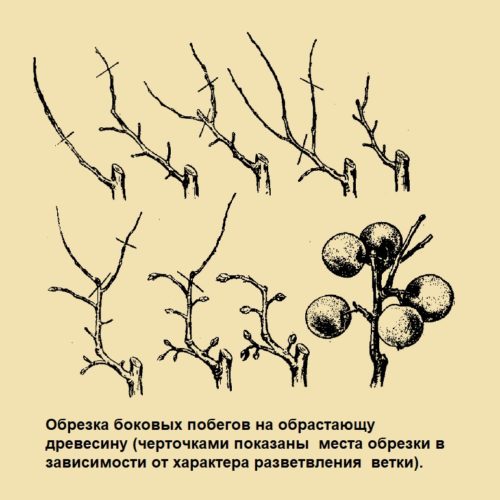

The first group includes varieties with poor bud excitability and weak shoot-producing ability (Cinnamon striped, Korobovka, Kitaika golden early, Titovka).
Trees of these varieties form long, thin branches. Due to the small number of fruit formations such as a spear and a fruit twig, the yield of these varieties grows very slowly. Pruning 1 / 2-2 / 3 shoots (strong shortening) promotes branching, and therefore, thickening of branches and the formation of a large number of fruit organs.
In young trees, strong annual shoots reach 70 cm, and moderately growing ones 35 cm. After pruning, strong shoots should have a length of about 40-50 cm, and weak and moderate-growing ones do not shorten.
Most pear varieties have a weak shoot-producing ability and, with a strong growth of terminal shoots, forms ankle branches. Pears are pruned in the same way as apple varieties of the first group, that is, they carry out a strong, and sometimes medium shortening.
The second group of varieties is characterized by good bud excitability and weak shoot-producing ability (Grushovka Moskovskaya, Arkad yellow, Borovinka). Trees of these varieties are distinguished by moderate branching and abundant laying of short fruit formations such as ringlets.
The predominance of the chain type of fruit wood is manifested in the frequency of fruiting. Moderate pruning (1 / 3-1 / 2 lengths) of annual shoots stimulates the emergence of growth shoots and increased development of weak fruit twigs.
The third group combines varieties with good bud excitability and shoot-producing ability (Autumn striped, Suislepskoe, Antonovka, Melba, Pepin saffron, Riga dove, Anis). Trees of these varieties branch well and bear fruit on various types of fruit formations.
Their shoots are shortened weakly in order to avoid excessive thickening of the crown, and more often thinning of intertwining shoots growing inside the crown is carried out. All intermediate shoots are turned into fruit branches by pruning. The overgrowing twigs located on the trunk and on the skeletal branches protect these parts of the tree from sunburn and improve their supply of nutrients.
To turn into overgrowing branches, the shoots are cut short, leaving 4-6 buds on them. The next year, several shoots are formed from these buds: the lower ones are short and the upper ones are long. One of the long shoots is shortened so that 4-6 buds remain, and the rest are removed.
As a result of this annual pruning, a branched fruit branch is formed. Weak shoots such as fruit twigs, especially those located horizontally, are not shortened.
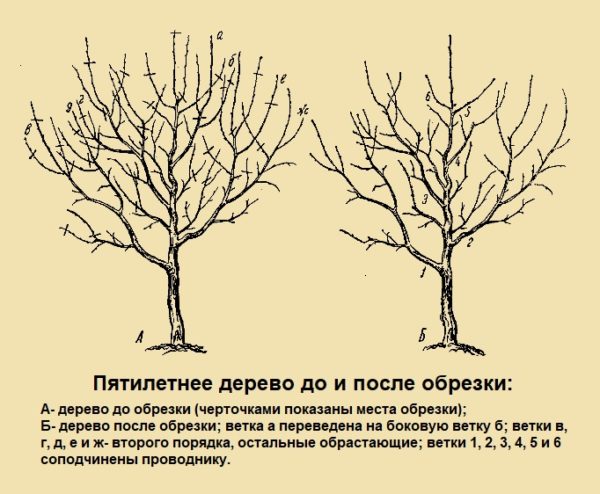

Pruning apple and pear trees that have begun to bear fruit
At the beginning of fruiting, the formation of skeletal and semi-skeletal branches ends. In the 2nd-4th year after the completion of the formation of skeletal branches, a conductor is cut out over the last lateral branch.This limitation of growth in height allows you to have low trees (4-4.5 m) and improve crown lighting. Growth of side branches is also limited by pruning over side branches.
Young fruit trees are pruned minimally. During this period, thinning is mainly carried out in order to remove unproductive semi-skeletal branches. They also cut out overlapping, rubbing, intertwining and hanging branches and shoots.
In apple trees bearing on ringlets (Antonovka, Grushovka Moskovskaya and similar varieties), as well as in pears, lateral shoots continue to be shortened, but to a lesser extent than before fruiting. In apple trees that bear fruit on fruit twigs (such as Cinnamon striped), the lateral growth of no more than 30 cm in length is not cut off.
Applicable and most famous types of activities
In choosing the type of formation, a novice gardener should clearly define the goal, which allows to implement any solutions for yield and landscape design:
- formative and regulating;
- rejuvenating and restorative;
- sanitary and preventive.
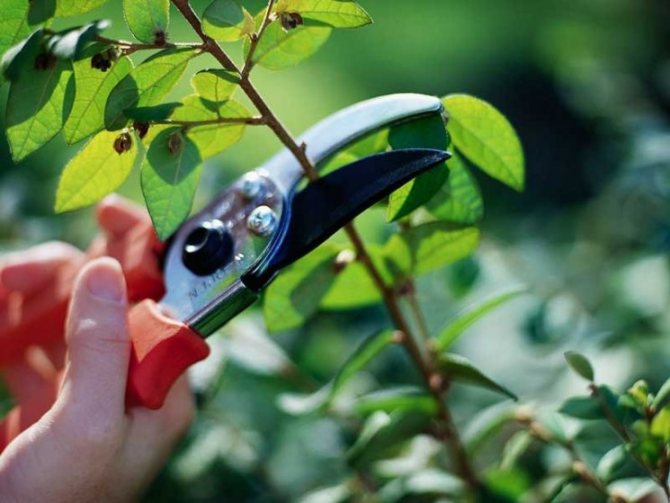

In the process of preparing for the implementation of the procedure, the size and age of the fruit tree should be taken into account; improper thinning and shortening can cause the crown to thicken.
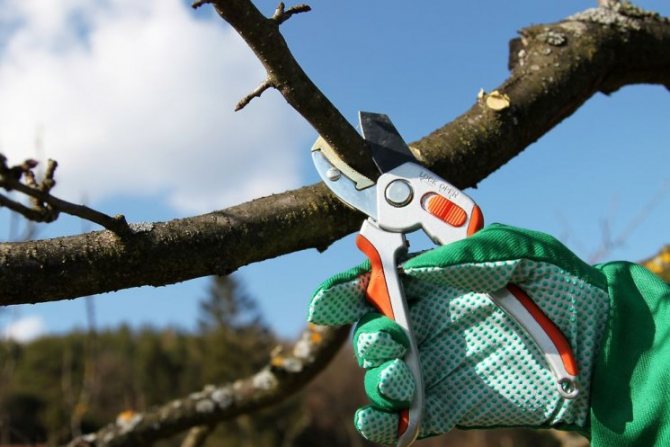

Pruning apple and pear during full fruiting
During the period of full fruiting, the crown of 15-30 year old trees is overgrown with a large number of fruits, and vegetative growth weakens every year.
The branching becomes so numerous that lack of nutrition leads to the formation of weak annelids, which do not lay fruit buds, and the growth shoots barely reach 15-18 cm.
The main task of pruning during this period is to obtain a normal (30-40 cm) annual growth, prolong the productive age of fruit formations and maintain the stability of the tree skeleton against fractures under the influence of the weight of the crop.
The shortening of skeletal and semi-skeletal branches gives a great effect in solving this problem. The amount of shortening depends on the condition of the trees. In trees that have stopped the formation of shoots of normal length or form them in small numbers, they produce slight rejuvenation by shortening the wood by 2-3 years old.
Skeletal and semi-skeletal branches are pruned for lateral ramification. Light rejuvenation is repeated after 3-5 years.
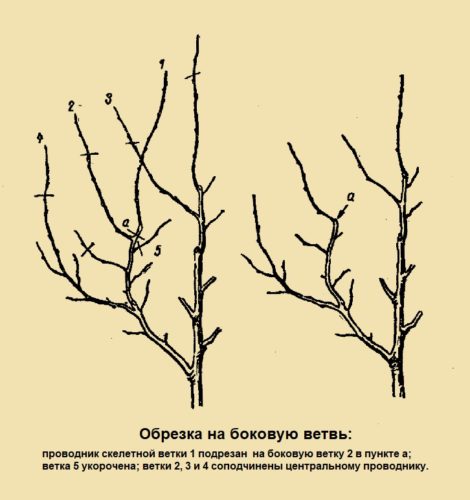

If the trees have not given good growth for a number of years, then all branches are shortened for 3-8 years old wood. The branch should be shortened for the last large growth, cutting it off above the lateral branching, strong ringlet or at the base of this growth, where there are a large number of dormant buds.
All lateral ramifications on the shortened branch are cut to 1 / 2-2 / 3 of the length, subordinating them to each other. In apple trees with a strongly drooping crown shape (Autumn, striped, Pepin saffron, etc.), the hanging parts of the branches are removed until the branches are directed upwards. Strong anti-aging is performed at intervals of 5-15 years.
The shortening of the branches of periodically fruiting trees is started regardless of the size of the annual growth. In such trees, the branches are shortened in a lean year. The formation of abundant growth caused by pruning diverts a significant part of the nutrients usually consumed for laying fruit buds, as a result of which fruiting becomes moderate.
Trees, whose abundant fruiting alternates with small harvests, rejuvenate in a big harvest year. When pruning, part of the fruit formations is removed, thereby improving the ratio between growth and fruit wood.
The next year, after shortening the branches, remove the excess shoots that thicken the crown, and shorten the terminal ones. Weak terminal shoots are also shortened so that they do not turn into fruit formations.
From top shoots, if they do not thicken the crown, form branches, guided by the general principles of pruning. The tops that thicken the crown are greatly shortened or cut into a ring.
To soften the frequency of fruiting of 20-30 year old trees, pruning and shortening of perennial fruit formations is carried out, while 1/3 to 1/2 of the fruit branches are removed. The more ringlets on the tree, the more they are removed. This primarily applies to apple varieties such as Antonovka, Grushovka Moskovskaya, Borovinka, Anis.
Detailed pruning of pear fruits is especially effective. Any type of pruning of fruit-bearing trees is accompanied by the removal of dry, diseased and unproductive branches from the crown.
When to prune fruit trees
Almost every gardener asks the question: when is it better to prune trees in the garden - in spring or autumn? In order not to damage future yields, fruit trees can be pruned 1-2 times a year: in early spring and in autumn-winter, when the plants are dormant. In the summer (especially late) they try to avoid pruning - at this time the tree should spend all its energy on growth and development, and not on eliminating the consequences of the "operation".
The exception is young trees with strong growth and low fruiting, for which pruning in early summer (until mid-June) may even be beneficial - excess shoots are removed, thus nutrients are supplied to the remaining ones, as a result of which fruiting improves.
Pruning young trees is advisable not earlier than the beginning of spring. For adult plants, you can form a crown both in late autumn (after the foliage has fallen, but always before the first frost), and in early spring (but not later than the beginning of the growing season). For especially large plantations in the area, when it is not possible to do all the procedures quickly, even winter pruning of trees is allowed - in this case, you need to work during thaw periods or at least in cases when the temperature does not drop below –7-10 ° С. If it is colder, there is a risk of getting uneven cuts, besides, wood that is fragile in the cold heals worse.
Pruning old trees
In old apple and pear trees, the frequency of fruiting is sharply expressed and the volume of the crown decreases due to the death of skeletal branches. Top shoots are formed at the base of skeletal branches. With the systematic chasing (slight rejuvenation) of the branches, this does not appear so brightly, and the trees continue to give a good harvest.
Also read: What determines the result of growing hazelnuts?
To improve the condition of neglected old trees, strong rejuvenation is necessary, while the branches are shortened by 1 / 2-2 / 3 of the length, that is, by 0.5-2 m from their top. Too much pruning, when everything over 2 m in length is removed at once, is not recommended, as this can lead to the death of the entire tree.
Pruning must be done above the growth shoot or fruit branch, without leaving the cut branches completely naked.
If the branches have already begun to be unlocked, and on their lower parts there are strong fatty shoots (tops), then the branches are cut to these tops. The older the tree and the more it is neglected, the more it has to be pruned.


In early spring, the soil under the rejuvenated trees is abundantly fertilized in order to cause strong shoot growth in the first year after pruning the branches.
When the trees give a good growth after rejuvenation, all the stumps are cut out, and the places of the cuts are covered with oil paint (ocher or mummy).
It is better to rejuvenate trees not immediately, but within two years, while the pruning of branches begins from the top. The upper branches and branches are cut more strongly, and the lower ones weaker. So, if the upper branches of the crown are cut off by 2/3, then the middle ones by 1/2, and the lower ones by 1/3 of their length.
The rejuvenation produced in this way, with good care and the application of a sufficient amount of fertilization, usually causes strong growth, the tree soon begins to bear fruit again and yields a harvest for 10 years or more.
Rejuvenation of trees is also used to restore them after severe freezing.
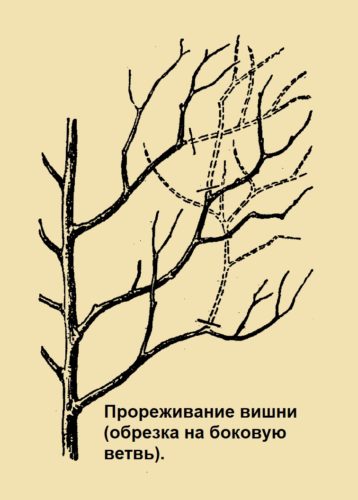

Parts of fruit trees
To perform pruning of fruit plantations in compliance with the rules of technology, you need to know the basic designations of the aboveground parts of trees, which are represented:
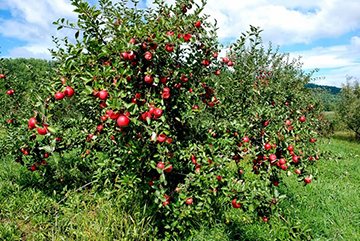

- the trunk, which is the main or central above-ground part of the tree;
- large skeletal branches extending directly from the stem;
- branches of the skeletal type or semi-skeletal branches extending from large skeletal branches;
- a stem stem located from the ground level to the very first large skeletal branch;
- the central conductor, or leader, which is the stem from the lowest skeletal branch to the top of the plant;
- shoots growing during the current season from buds that are on last year's growths or from dormant buds;
- overgrown branches, or so-called "overgrown wood", which is represented by ramifications growing on parts such as the central conductor, skeletal branches or ramifications;
- spinning tops, or growths growing upward from dormant buds on large skeletal branches or ramifications.
The speed of growth processes of all aboveground parts of the tree directly depends not only on compliance with the pruning technology, but also on the level of development of the root system of fruit plantations.
Correct pruning of fruit crops, taking into account the growth processes of all aboveground parts, contributes to an increase in yield, improves the quality of formed fruits, accelerates the entry of the plant into fruiting and smoothes the frequency of harvest.
Pruning and shaping stone trees
Stone fruits are fast-growing, so the process of forming crowns is shorter than that of an apple tree, and lasts 5-6 years. Pruning speeds up the formation of trees, but it must be carried out in a good agricultural background, otherwise pruning in exhausted and weakened trees will cause gum leakage.
Cherries and plums are formed according to a combined system or give trees a bushy shape, especially of coppice varieties. The branches are placed on the trunk in groups (2-3) and singly. A distance of 8-10 cm is left between the branches in tiers, 25-35 cm between groups.
Adult trees of bushy and coppice forms should have 8-10 branches, 10-15 tree branches. On the branches of the first order, branches of the second order are formed, placing them at a distance of 20-30 cm from each other alternately on both sides of the axis of the skeletal branch.
After planting, the trees are pruned based on general pruning principles. Skeletal branches are shortened, achieving subordination of the branches, while the top of the conductor should be 15-25 cm higher than the ends of the lateral branches.
Shoots that are unnecessary for the formation of skeletal branches are cut out or greatly shortened, turning into overgrowing branches.
Features of pruning cherries.
Cherry, depending on the size of the trees, the nature of growth and fruiting, are divided into two types, tree and bushy. Cherry varieties Vladimirskaya, Lyubskaya, Fertile Michurina are bushy. They form small trees with and without low boles. They bear fruit mainly on annual shoots.
Long growths (40-50 cm) bear a large number of both fruit and growth buds, short ones usually have only one apical growth bud, and all lateral buds are simple fruit buds.
Lateral formations on short growths after fruiting, the branches die off, become bare, slightly thicken and hang down. The main task of pruning bush cherries is to maintain vigorous shoot growth.
Only vigorous shoots (40-50 cm long) are shortened, thus causing their branching. A weak one-year growth is not shortened, since this removes the only growth bud and, after fruiting, the shoot dies off.
The main type of pruning is thinning. Sick, thickening crown and dry branches are cut out. It is better to cut not on the ring, but on the lateral branch.
When the growth of shoots is attenuated and the branches are significantly exposed, they are slightly rejuvenated by cutting them off into a strong lateral branch located on 2-3 year old wood. If necessary, make a deeper rejuvenation for 3-5 years old wood. At the same time, the branches of the second order are shortened.
Cherry varieties Krasa Severa, Amorel Nikiforova, Korostynskaya and others form relatively large trees, bear fruit on annual shoots and bouquet branches located on 2-5 year old wood. Good branching promotes thickening of the branches.
Pruning a tree cherry is similar to pruning a bushy cherry, however, in addition to cutting young trees, shortening is used in order to subordinate branches, remove forks and strengthen fruit branches. Only long shoots are shortened, and short ones are left without pruning.
Features of pruning plum.
There are plum varieties that bear fruit mainly on annual shoots, and varieties that carry the main crop on bouquet twigs and spurs. Strong annual shoots have fruit and growth buds in the middle part, located together in groups (2-3 buds), and only growth buds at the end and at the base.
Taking into account the peculiarities of the placement of buds, strong shoots are pruned weakly so as not to destroy the crop and not cause excessive branching. Weak shoots with a growth bud at the end are not cut off.
Cultivars bearing fruit on bouquet branches and spurs are pruned slightly more (by 1 / 5-1 / 7 of the shoot length), which enhances the growth of short fruit formations, which are short-lived in the plum. Otherwise, pruning is similar to cherry pruning.
Shaped trees, how to shape a tree
Tree shaping is a suggestion for the assertive and gardener who likes to experiment. A properly formed tree takes on an individual character. By pruning a tree, the gardener plays the role of a stylist, transforming the plant into a unique piece of art as a distinctive plant.
Trees intended for formation should be characterized by: good health, regular cut, not very fast growth, good condition after a strong cut, the ability to release numerous new shoots after pruning, frost resistance.
Species particularly suitable for molding include: linden, hornbeam, maple, hazel, plum, willow, and fruit trees such as apple and pear.
Tree formation: when and how
Trees must be formed in the first year after planting. If the plants were planted in the fall, the first cut is done in the spring, and when planted in the spring, it is also better in the spring. We form twigs when they are young and not woody. We make cuts on sunny and dry days.
It is not recommended to carry out this treatment on rainy days, as high air humidity contributes to bacterial and fungal infections. The main deciding factor for the cut period is the flowering time. From February to the beginning of the growing season, trees are cut, which bloom in summer and autumn.
Ornamental trees that bloom in spring are cut immediately after flowering. It is recommended to shorten the shoots gradually, cutting them in short sections. Care should be taken when choosing and cutting, to get started with detailed information about each plant.
Running trees on metal frames
Garden shops stock frames in several patterns, but if you want a tree with a unique shape, it's best to make your own. It is necessary to plan the shape of the frame and then make it out of galvanized wire and metal rods.
We are planting a tree with a frame set in the ground. Growing shoots are sprinkled on the supports, we bend or attach, removing those that protrude beyond the frame. Trees formed by the walls of buildings or massive fences are interestingly presented.
In this case, casting is also done on the racks.Forming trees of a certain shape, unfortunately, is not a short-term and simple process, but it is worth trying to find a tree in the garden that will be the pride of every owner.

